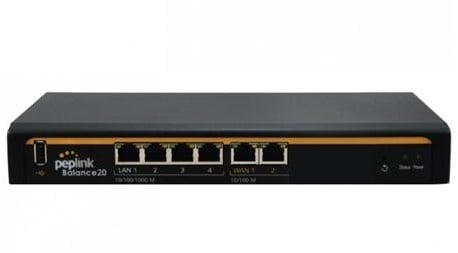There are many ways the IoT can leverage, and be leveraged by, VoIP systems to create a more productive workplace.
TeleDynamics Think Tank
Daniel Noworatzky

Recent Posts
The benefits of integrating the IoT with your VoIP phone system
Topics: VoIP, SIP, Peripherals, Software Integration, Trends, Productivity
Give superpowers to your WAN through software management
An SD-WAN can be up to 2.5 times less expensive than traditional WAN architecture.
One of the most challenging situations for networking professionals over the years has been how to interconnect remote sites and branch offices so users at all locations can enjoy the same quality of network and telephony services in a secure and timely manner. One way to do this is to duplicate all services at each location. However, this can become administratively unwieldly, not to mention prohibitively expensive.
The solution is the use of wide area networks (WANs), where centralized services like voice and data reside at headquarters and can be provided to the remote users as if they were all physically located inside the headquarters’ LAN (local area network). In this article, we look at the different ways to deploy WAN, as well as the problems solved and business benefits to be gained by using software-defined WANs (SD-WANs).
Topics: QoS, Total Voice Solution, Trends, Network Design, Cloud
Improve worker collaboration through presence technology
A useful yet vastly underused functionality of SIP is what is known as presence technology. According to Salesforce, 86% of executives surveyed blamed lack of collaboration or ineffective communication for workplace failures. This is where presence can help.
Topics: Business Telephone System, VoIP, SIP, Mobility (including remote work), Productivity
When providing services for your customers, it’s all about convenience. Imagine a customer trying to find out some information about your service from your website. Her question is very specific and can’t be answered by the FAQs you have on the site. She spots a button on the bottom right of the screen that says “Can’t find what you’re looking for? Talk to a rep now!” She clicks it and is immediately connected via voice to a customer representative and gets her question answered on the spot. Now that’s service!
This is just one of the functionalities that Web Real-Time Communications (WebRTC) provides. A survey conducted by The SIP School found that 88% of professionals have either never heard of WebRTC or only have a cursory understanding of it. Here we present a few facts that will help you better understand how it can benefit your business.
Topics: Customer Service, Business Telephone System, SIP, Total Voice Solution
Improve your customers’ digital dexterity with VoIP
It seems like everyone is talking about digital transformation these days. Technology is changing the way business is done at a mind-boggling pace, and making sure their companies are able to adapt to this change is a top priority for today’s business leaders – 81% of CEOs said keeping up with new technologies was their chief concern in a recent KPMG survey.
As a telephony dealer, you can help your customers on their digital transformation journey by intelligently leveraging their VoIP telephone system. And the good news is, it’s easier than many people think.
Topics: Customer Service, IP PBX, Business Telephone System, VoIP, Total Voice Solution, Software Integration, Trends, Network Design, Cloud
Last week, we touched on some of the technological advances that have allowed VoIP telephony to surpass the PSTN in both quality and reliability.
Yet, even though VoIP has been around for two decades, there are still some misconceptions about what it really is. A lot of people think of VoIP as a technology that allows placing phone calls over the internet. Although this is true, such a narrow definition encompasses only a fraction of the functionality of VoIP.
The unfortunate consequence of this misperception is that VoIP is often associated with low quality and best-effort services that offer low cost or free voice calls over the internet. Those familiar with these services have experienced the frequent disconnects, jitter and stuttering on the line characteristic of this type of service. As a result, VoIP has erroneously been associated with an unreliable user experience.
The truth is, VoIP is much more (and better) than just voice over the internet.
Topics: OTT VOIP, QoS, Business Telephone System, VoIP, SIP, Mobile
The most recent FCC Voice Telephone Services report, published in November 2016, states that two thirds of businesses in the United States are still using switched access telephone lines (PSTN or POTS). The reasons they haven’t yet migrated to VoIP (voice over internet protocol) are varied. One of the most prevalent myths about VoIP is that the quality is not as good or reliable as that of traditional telephone lines. The truth, however, is that VoIP technology has evolved to a point where the audio quality is generally as good if not better than analog lines.
Here we list some of the technological developments that have allowed VoIP to surpass even PSTN voice quality, some of which may surprise you!
Topics: QoS, Business Telephone System, VoIP, Trends
Implementing VoIP safely and efficiently on the network edge
Voice over IP networks can be challenging to implement efficiently and securely. This is in part because voice packets require specialized management and must be treated differently than normal data packets. Quality of Service (QoS), security and flow control are just some areas in which the required handling of voice traffic differs from conventional data traffic.
The good thing is that with the proper expertise and care, many of these issues can be successfully dealt with within the corporate network. Such networks are under the complete control of the network administration team and thus can be fully customized for the needs of the voice being transmitted.
However, what happens when voice packets are routed beyond the corporate network, either for voice calls to the PSTN or mobile network, or for employees who use internal voice network services remotely? Here we look at various network edge mechanisms that can be used to monitor and manage data traveling in and out of the LAN.
Topics: QoS, VoIP, Total Voice Solution, Trends, Network Security, Network Design
What network convergence can do for your company
When most people hear about VoIP, they think of telephony over the internet. Online services that offer extremely-low-cost phone calls or even free calls may come to mind. Although such services do utilize VoIP (voice over internet protocol), IP telephony in a broader sense is technology and architecture that uses VoIP to allow you to create an internal telephone network within your organization that leverages the existing data network infrastructure.
IP telephony operates on converged network, which supports both voice and data. The advantages of this to a business are numerous and are well worth the investment. If you are considering a migration to IP telephony, here we present some information that can help get you on track.
Topics: Business Telephone System, VoIP, SIP, Trends, Productivity
Get high throughput without high cost using Peplink’s Balance Router
Product review
There are several ISPs (internet service providers) that can provide your business with high- and super-high speed internet access. These technologies include Metro Ethernet and Fiber to the Premises (FTTP) and offer speeds from several Mbps to 1 Gbps and beyond – but with a hefty price tag.
An alternative is the bonding of multiple ADSL/VDSL or cable lines to take advantage of the aggregate bandwidth of these connections while paying a comparably miniscule monthly cost. All that’s needed is a load balancing WAN router like Peplink’s Pepwave Balance 20 Dual-WAN Router.
Designed for small office and branch office use, not only does the Balance 20 router perform link bonding and load balancing, but it also offers an impressive array of additional features.
Topics: Business Continuity, Routers
Welcome to our Think Tank
In this blog you'll read our thoughts on business telephone systems. While a lot has changed in telecom since TeleDynamics was founded in 1981, we remain as committed as ever to delivering the best customer service in the industry.
If you would like elaboration on a specific topic, please let us know in the comments section.
Happy reading and thanks for stopping by!
Receive New Articles by Email

Recent Posts
Posts by Topic
- 5G
- AI
- Android
- Avaya
- Bluetooth
- Boom Collaboration
- Business Continuity
- Business Strategy
- Business Telephone System
- Case Study
- Catalog
- Cisco
- Cloud
- Collaboration
- Communication
- Conferencing
- Cordless
- CPaaS
- Customer Service
- Customer Success Story
- CyberData
- DECT
- E911
- Events
- Facility Management
- Firewall
- Firmware Upgrades
- FoIP
- Gateway
- Grandstream
- Headsets
- Home Security
- IoT
- IP PBX
- Jabra
- Konftel
- Leasing
- Microsoft
- Mobile
- Mobility (including remote work)
- NEC
- Network Design
- Network Infrastructure
- Network Security
- News
- OTT VOIP
- Outsourcing
- Panasonic
- Peripherals
- PoE
- Polycom
- Power Management
- Product Review
- Productivity
- Protocols & codecs
- QoS
- Regulations
- Routers
- SD-WAN
- SIP
- SIP Phones
- Snom
- Software Integration
- Surveillance
- Switches
- Total Voice Solution
- TP-Link
- Trends
- Troubleshooting
- UCaaS
- Unified Communications
- Videoconferencing
- VLAN
- Voicemail
- VoIP
- VoWi-Fi
- VTech
- WAN Technology
- Wi-Fi
- Wireless
- WISP
- Yealink
- Yeastar
- Zoom















